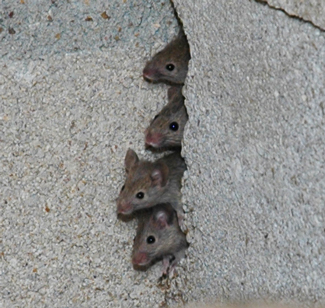Mice in Kittery, Maine
By Chris Williams on March 12, 2015.
 Problem: Mice in Apartment
Problem: Mice in Apartment
Tenants move out of rental property due to mouse droppings in cabinets near dishwasher, and dishwasher itself. One sighting of live mice in 2nd floor bedroom. Management company moves quickly to resolve any issues and return property to rental market. Colonial Pest Control was called to investigate and manage mouse infestation.
Inspection Notes
The house was well built, in the luxury class of area homes, surrounded on all sides by woodlands and fields, facing an estuary. Despite the previous tenants’ trash accumulating beside the detached garage, and over two feet of snow, the house was in good shape. Mouse droppings were noted in the cabinet near the dishwasher, and inside the dishwasher. No other evidence such as rub marks, gnawing, or dead mice were observed on the first and second floors. In the basement, the root cause of the problem was discovered. The interior door sealing off the bulkhead was broken at the bottom and did not close properly at the top, allowing mice to enter freely.
Further inspection revealed heavy rub marks leading to and from the addition crawl space. Once inside the crawlspace, I noticed an open window with the screen pushed open by snow and ice, and a visible gap in one of the foundation joints leading outside. I sealed the gap and noted the open window. One other cellar window was open but the screen was intact. Four dead mice were removed from the cellar, light to moderate amounts of droppings were noted. Due to the deep snow pack, exterior inspection could not be performed, and was scheduled for a later date. Evidence of mouse activity was also noted in the garage, although that was not the main issue.
Why and how do mice enter homes?
Mice enter a house to escape from predators and the elements. Once mice get inside and find a nesting site, nuts and seeds may be stored in small caches nearby. The warmth provided by the heating system along with their stored food makes for nice living. Unlike mice outside in the wood pile, these mice can rest easy, even mate and have babies. The mice outside must constantly eat to stay warm while evading predators such as weasels, fox, fisher cats, cats, birds of prey and coyotes. Common construction methods often leave openings at corners, behind steps, at the roofline, chimney flashing, bulkheads, and garage door frames to name a few. Mice can get through openings as small as 1/4 of an inch wide, or the size of the human pinky finger tip.
Much can be done by the homeowner to correct these construction defects and prevent rodent entry. Smaller openings can be filled with caulking or other suitable material. Expandable foam, stainless steel mesh, copper mesh, metal flashing, and wood pieces are some examples of what can be used to exclude rodents such as mice, rats, red and grey squirrels, flying squirrels, and bats.
Treatment
During the inspection, the maintenance man from the management company was taking notes and asking questions. We devised a strategy to solve the mouse problem together. Colonial Pest Control placed safe and effective bait products to remove the existing mouse population, sealed off any visible gaps from the inside, and will return once the snow pack melts to investigate and seal the exterior as needed, or make recommendations for same. Management will seal and fix interior bulkhead door, close open screens, and work to enclose crawlspace entryways as needed. We offer a 6 month warranty on our work and have great success!
If you or your family has a mouse issue, do not wait! Call the professionals at Colonial Pest Control to solve the problem!
Photo credit: JosephSardin / Foter / CC BY
Stay up-to-date with Colonial Pest’s email newsletter!